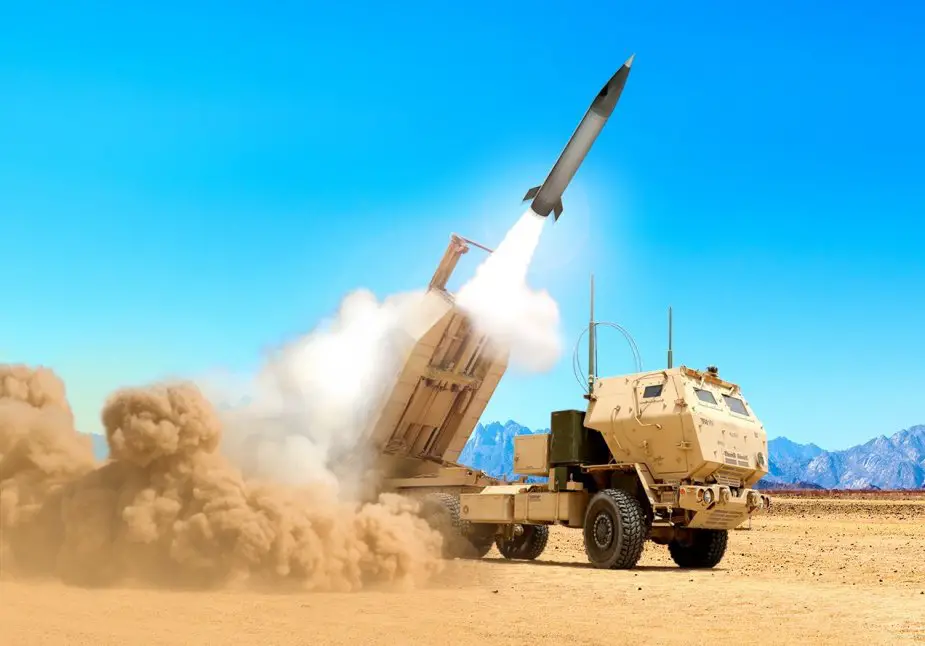Breaking news
U.S. Army begins testing advanced seeker for Precision Strike Missile.
The U.S. Army has successfully completed its first open-air testing of an advanced multi-mode seeker, an upgrade to the Precision Strike Missile system. During a two-day test period June 2-3 at Redstone Arsenal, Alabama, research teams operated the seeker at 50 percent capacity while tracking moving targets. The seeker was designed to allow an upgraded “Spiral One” missile to acquire targets on both land and sea. Joseph Lacdan, Army News Service, reports.
Follow Army Recognition on Google News at this link

An artist's rendering shows the launching of a Precision Strike Missile. On June 4, 2020, Brig. Gen. John Rafferty, director of the Long-Range Precision Fires Cross-Functional team, discussed testing of an advanced, multi-mode seeker that will serve as an upgrade to the missile (Picture source: Lockheed Martin)
Scientists mounted the seeker on a pod, which was placed under the wing of an aircraft. Then the research team had the aircraft flown over the testing range at Redstone to track the radio waves of moving targets. “We think we’re on the right track,” said Brig. Gen. John Rafferty, director of the Long-Range Precision Fires Cross-Functional Team. Rafferty discussed the testing Thursday from Huntsville, Alabama, during a media roundtable briefing.
The multi-mode seeker was developed from the Land-Based Anti-Ship Missile program that began in 2015 to help the Army target enemy ships with its long-range precision fires capability. However, the Army soon realized the seeker not only had the ability to track the radio signals of moving ships but also land-based targets such as communications vans and the mobile radars of anti-aircraft defenses.
The capability gives the Army the means to succeed in a difficult anti-access, aerial-denial environment, officials said. The use of multiple sensors also increases the ability to locate targets even without good coordinates. “We think that's going to provide a significant advantage to us in our long-range fires, rockets and missiles,” said Mike Turner of the Aviation and Missile Center at Redstone.
Rafferty said the Army expects to field the Precision Strike Missile in 2023 and integrate Spiral One into the force by 2025. The Precision Strike Missile will extend the firing range of the current Army Tactical Missile System, or ATACMS, by more than 500 kilometers, he said. “We've got our eyes wide open on the development of this program,” Rafferty said. “And so on our [CFT], we have a small intelligence and targeting team. And one of their primary functions is to make sure that in our approach to developing weapon systems that we have the right targets in mind. And we do that through a very open and routine dialogue with our Army service component commanders in Europe and the Pacific.”
Rafferty added that the miniaturization of onboard processing made a more powerful processing unit that helps the multi-mode seekers to work together. Rafferty said the next step will be to deploy the device at full capacity in a more challenging, deliberate testing environment. Testing will move to White Sands Missile Range, New Mexico, this fall. “We also want to explore targets across multiple domains,” Rafferty said. “And that's what we believe this multi-mode seeker will give us the ability to do. [The testing] was a very, very important first step in demonstrating the maturity of the technology and the promise for integrating it into the missile for delivery as quickly as we can.”
The testing team had to overcome the challenges of successfully navigating the tests in a pandemic environment. Fortunately, Rafferty said, much of the hands-on engineering work had already been completed. He credited industry partner, Lockheed Martin, with employing strict safety measures and successfully maintaining a rigid testing schedule.
“It was very inspiring to me, the lengths that they went to maintain the schedule and to deliver a successful test,” Rafferty said. “But also the lengths that they went to, to protect their workforce and the measures they put in place in the factory and in their laboratories.”


























